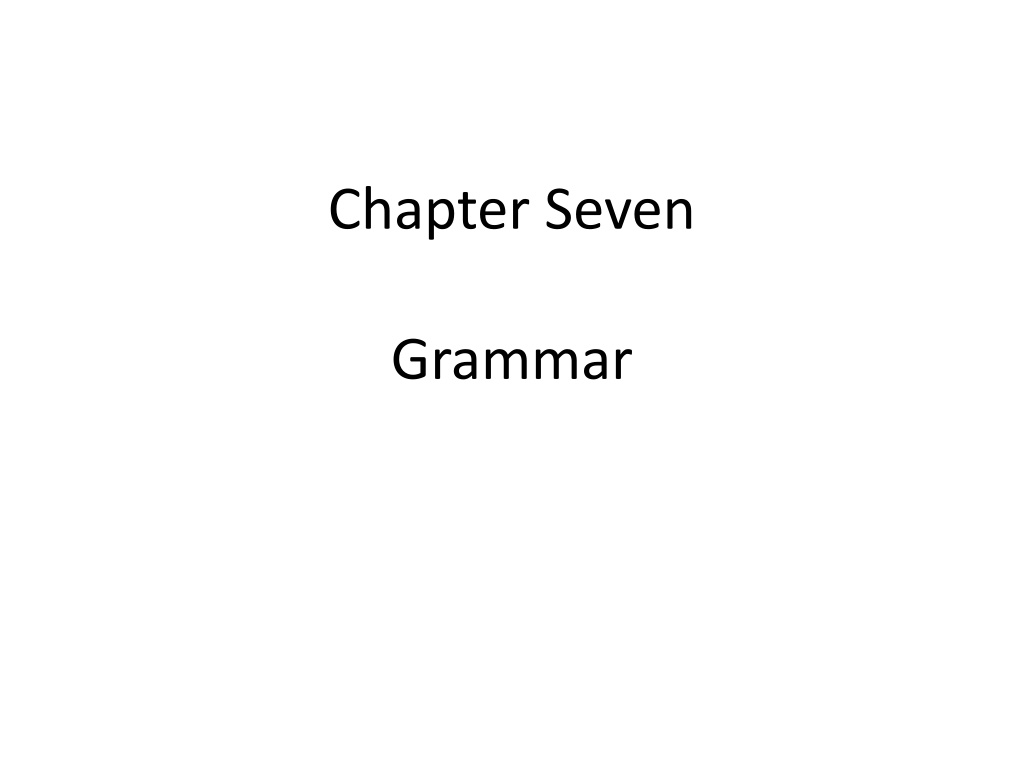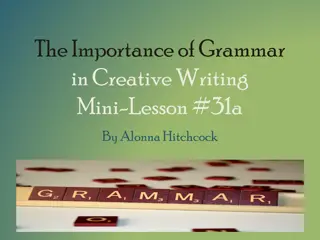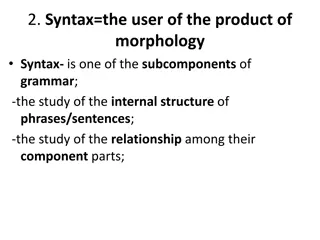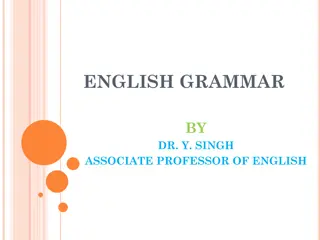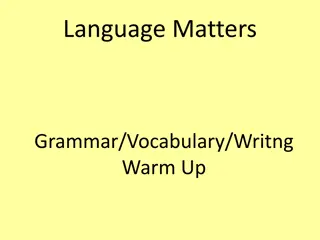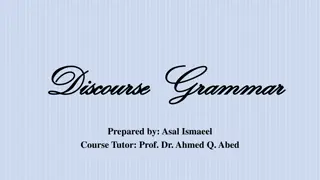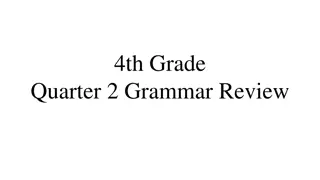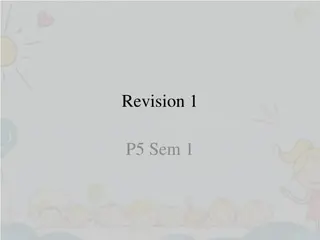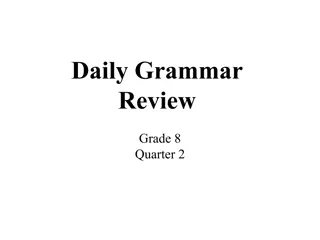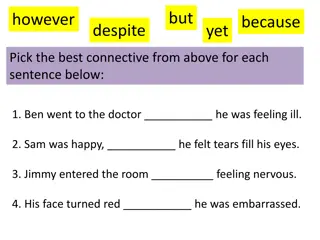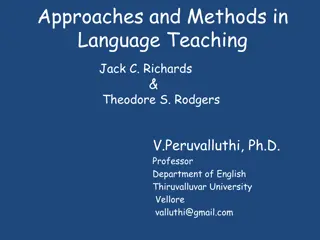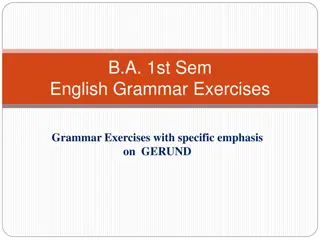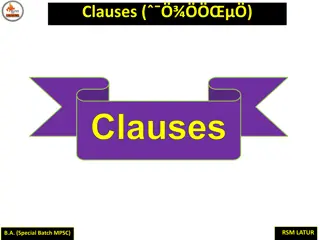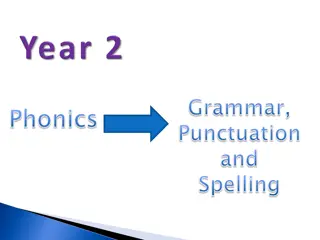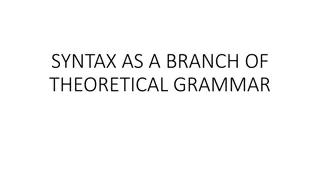Understanding Grammar: A Comprehensive Overview
Explore the fundamental aspects of grammar, including phonology, morphology, and syntax. Discover how languages structure sentences and phrases, and delve into traditional grammar concepts such as parts of speech and agreement. Gain insights into the historical importance of Latin and Greek in shaping grammatical descriptions. Unravel the complexities of language rules and patterns in various linguistic systems.
Download Presentation

Please find below an Image/Link to download the presentation.
The content on the website is provided AS IS for your information and personal use only. It may not be sold, licensed, or shared on other websites without obtaining consent from the author. Download presentation by click this link. If you encounter any issues during the download, it is possible that the publisher has removed the file from their server.
E N D
Presentation Transcript
Chapter Seven Grammar
Introduction 2 levels of description in the study of language --sound sequences as represented in phonetic alphabet an described in terms of their features --sequence of morphemes (e.g. the lucky boys) With these descriptions, we could characterize all the words and phrases of a language in terms of their phonology and morphology
Grammar These words can only be combined in a limited number of patterns: e.g the lucky boys acceptable or grammatical * Boys the lucky * lucky boys the (unacceptable or ungrammatical) English has strict rules in combining words into phrases. Hence the sequence: article + adjective + noun
Grammar: The process of describing the structure of phrases and sentences in such a way that we account for all the correct grammatical sequences in a language and rule out all the ungrammatical sequences. Swahili, Tagalog, Arabic and Turkish all have their own ways of forming grammatical phrases and sentences.
Traditional Grammar The grammar of Latin and Greek was taken as the model for other grammars, including English, because there were well-established grammatical descriptions of them. Latin and Greek were the languages of scholars, religion, and knowledge. The best- known terms from the traditional grammar is used in describing parts of speech.
The parts of speech: Nouns, articles, adjectives, verbs, adverbs, prepositions, pronouns, conjunctions (Refer to pg. 82)
Agreement Traditional grammatical analysis has also given us a number of other categories such as: number, person, tense, voice and gender. These categories are clearer when we consider them in terms of agreement. E.g. loves ( the verb) agrees with (the noun) Cathy in the sentence: Cathy loves her dog
Cont The agreement (between verb and noun) is based on: the category number, i.e. the noun is plural or singular. It is also based on the category person (first, second, third). The different forms of pronouns are used (I, you, he/she/it). Hence, third person singular (noun--Cathy) agrees with the verb loves (not love). Tense verb loves is a present tense. Voice active or passive - here in the active voice (describing what Cathy does ) Gender her (natural gender male and female entities) e.g. he/she; his/her; it (..loves her dog)
Grammatical gender English Biological gender or natural gender (male and female) Other languages such as Arabic, German and Spanish use grammatical gender/ nouns are classified according to their gender class (masculine and feminine) and not tied to sex.
Cont Spanish has 2 grammatical genders masculine and feminine; e.g. el sol (the sun); la luna (the moon) German uses 3 genders masculine der Mond (the moon); feminine die Sonne (the sun), and neuter das Feuer (the fire) The different forms of the articles in both Spanish and German examples correspond to differences in the gender class of the nouns. French le livre (the book) is grammatically masculine but is not considered to be biologically male! Arabic ( ) however the sun is not considered a female! Latin also has grammatical gender. So the grammatical gender category is useful in a number of languages but not in English.
Traditional analysis In traditional grammar books, tables were presented to describe English verbs and compare them to Latin verbs The forms for the Latin verb Amare (to love) are listed on pg.85. It is clear from the table that each Latin verb is different according to categories of number and person but in English they are all the same but one. Thus, in English, it makes more sense to say the categories of person and number describe different pronouns and not verbs as in Latin (one of the arguments against the traditional approach)
1- The prescriptive approach 18thc. The prescriptive approach proper use of English borrowed from the structure of sentences in Latin. E.g you must not split the infinitive; you must not end a sentence with a preposition Who did you go with? With whom did you go? Mary runs faster than me. Mary runs faster than I. Don t begin a sentence with I OR AND These are all prescriptive rules
Captain Kirks infinitive You must not split the infinitive The English infinitive has the form to + the base form of the verb as in to go / it can be used with an adverb e.g. boldly. To boldly go (star trek) his teacher would expect him to say to go boldly or boldly to go so that the adverb does not spilt the infinitive. This is from Latin (ire) because Latin infinitives are single words and just do not split.
2- The descriptive approach 20THc. The categories and rules that were appropriate or Latin grammar just did not seem to fit the non-European languages. So analysts collected samples of the language they were interested in and attempted to describe the regular structures of the language as it was used not according to some view of how it should be used.
2/a Structural Analysis One type of descriptive approach is structural analysis. Its main concern is to investigate the distribution of forms in a language. The method uses test-frames with empty slots. Examples on pg 87
E.g. The ________ makes a lot of noise. I heard a __________ yesterday. Forms that fit in the slots (car, child, donkey, dog, radio)/ they are likely to be examples of the same grammatical category; i.e. noun We notice that other forms do not fit in the slot, e.g., Cathy, someone, the dog, a car. So, we propose another test frame:
E.g. _________ makes a lot of noise. I heard ________ yesterday. Other forms that fit this test frame e.g. (it, the big dog, an old car, the professor with the Scottish accent )/ examples of the same grammatical category, i.e., noun phrases Therefore, the definition of pronouns can be updated from words used in places of nouns to words used in place of noun phrases and nouns As a result, a description of the sentence structures in a language can be produced.
2/b Constituent analysis Another descriptive approach is constituent analysis. How small constituents (components) form larger constituents./ i.e., determining how words go together to form phrases Example An old man brought a shotgun to the wedding. it has 9 constituents/ how do they go together to form larger constituents (phrases)? An old man brought brought a shotgun to to the (wrong)
Noun phrase Verb phrase Prepositional phrase an old man brought a shotgun to the wedding
Using this diagram can help us determine which forms can be substituted for each other. It also shows that proper nouns and pronouns can be, though they are single words, can be used as noun phrases and fill the same constituent space as longer phrases. (see pg. 88)
2/c Labeled and bracketed sentences Another type of diagram that is designed to show how the constituents in a sentence can be marked by using labeled brackets. E.g. the dog loved the girl. They are bracketed at: The word level [the] , [dog] The phrase level [the dog] , [loved the girl] And the sentence level [the dog loved the girl] Then we label each constituent with grammatical abbreviations (see p. 89) This procedure reveals to us the hierarchal organization of these constituents. Thus, consituent analysis is useful for describing the structure of English sentences and how words and phrases are combined to form grammatically correct sentences (not only English but other languages as well.)
Examples 1. A Gaelic sentence: the boy saw the black dog (see p. 90) The diagram shows that It follows a (V NP NP) structure, unlike the English (NP V NP) structure 2. Arabic sentence: Saw the boy the dog the black In the Arabic sentence, the verb comes first, also, the adjective goes after the noun, unlike in English. This kind of analysis may help us understand why foreign language learners produce grammatically incorrect sentences of the target language.
